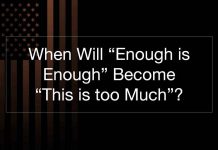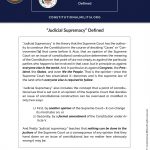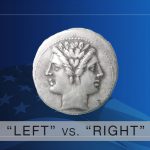Last Updated on October 3, 2021 by Constitutional Militia
The more I scan the Internet these days, the more disappointed I become, because of the ever-increasing superficiality, triviality, and truly aggressive contempt for the intelligence of the audience that characterizes so much of what passes for political discourse in this country. The average cookie sheet has more depth, and certainly produces a more palatable product, than the typical politically oriented Internet column or blog.
A glaring example is the recent creation by the Southern Poverty Law Center (“SPLC”) of a section on its web site entitled “Meet the ‘Patriots’”. Now, I must admit that I probably should not trouble myself (or the readers of my commentaries) with this matter had the SPLC not chosen to “profile” me among its list of “Patriots”. But, the SPLC having done so, I believe I am entitled to “return the compliment” as it were. Besides, the SPLC has provided me with “a teaching moment” which should not be wasted.
1. The most obvious demerit of the SPLC’s performance is its lack of basic logic. Throughout, “Meet the ‘Patriots’” is a patent example of the fallacy petitio principii (“begging the question”). The SPLC’s web site purports to present “profiles of 36 individuals at the heart of the resurgent” “antigovernment ‘Patriot’ movement”. Unfortunately—or, perhaps more likely, intentionally—the SPLC provides no definition of the key term “antigovernment ‘Patriot’ movement”. In what sense these “profiled” individuals are “antigovernment”, or in what sense they are merely faux “Patriots” rather than real patriots, or in what sense a real “patriot” can be “antigovernment” as a consequence of being a “patriot” the SPLC never explains. This renders the entire exercise nonscientific—because, without these definitions, the SPLC’s categorizations of the “36 individuals” as “antigovernment” and therefore somehow false or bad “Patriots” are neither verifiable nor falsifiable. They are simply crude propaganda below even the kindergarten level of reasoning.
As I understand matters, an “antigovernment patriot” is a contradiction in terms. A “patriot” loves what is good about his country and defends its just interests. Thus, a patriot respects his country’s government. Indeed, in America “patriots” are the very source of and authority for government. As the Declaration of Independence explains, “Governments are instituted among Men, deriving their just powers from the consent of the governed”; and “whenever any Form of Government becomes destructive of these ends, it is the Right of the People to alter or to abolish it, and to institute new Government, laying its foundations on such principles and organizing its powers in such form, as to them shall seem most likely to effect their Safety and Happiness”. And the Constitution itself attests that “WE THE PEOPLE * * * do ordain and establish th[e] Constitution”. So no “patriot” can be “antigovernment”.
Of course, not every action taken under color of law by every individual in public office is lawful, and therefore “governmental” in character. For example, Title 18, United States Code, Section 242 provides that
[w]hoever, under color of any law, statute, ordinance, regulation, or custom, willfully subjects any person in any State, Territory, Commonwealth, Possession, or District to the deprivation of any rights, privileges, or immunities secured or protected by the Constitution or laws of the United States, or to different punishments, pains, or penalties, on account of such person being an alien, or by reason of his color, or race, than are prescribed for the punishment of citizens, shall be fined under this title or imprisoned not more than one year, or both; and if bodily injury results from the acts committed in violation of this section or if such acts include the use, attempted use, or threatened use of a dangerous weapon, explosives, or fire, shall be fined under this title or imprisoned not more than ten years, or both; and if death results from the acts committed in violation of this section or if such acts include kidnapping or an attempt to kidnap, aggravated sexual abuse, or an attempt to commit aggravated sexual abuse, or an attempt to kill, shall be fined under this title, or imprisoned for any term of years or for life, or both, or may be sentenced to death.
Self-evidently, the persons within the contemplation of this statute who act “under color of any law…” are rogue public officials of various kinds. Such miscreants pretend to act in the capacity of “government”, but actually are acting in an “antigovernment” capacity, because their acts are in violation of this particular law and no doubt of many others.
So, are “patriots” who oppose rogue public officials “antigovernment”? Quite the contrary. It is every citizens’ duty —and the duty of every loyal public official—to oppose, resist, and utterly defeat the machinations of each and every rogue public official. A “patriot” is one who opposes rogues in public office—and the political parties, private special-interest groups, factions, and organizations that work hand in glove with them.
Such is my definition of a “patriot”, supported by the Declaration of Independence, the Constitution, and the laws of this country. The SPLC has chosen to “profile” me as an “antigovernment ‘Patriot’”—of whom, one must presume from the tenor of “Meet the ‘Patriots’”, the SPLC disapproves. Yet, if the SPLC disapproves of me as a “patriot”, then what is its definition of “patriotism”? Plainly, its definition and mine cannot be the same.
2. By carefully avoiding key definitions, the SPLC is able to lump a number of disparate individuals together in its “profiles”—leaving the careless reader to draw the unsubstantiated inferences that: (i) all of these individuals share some common, and presumably nefarious, beliefs; (ii) based upon these beliefs, in some vague manner they are all engaged in a common, and also presumably nefarious, undertaking; and (iii) if some of them have allegedly engaged in supposedly illegal activities, then the rest of them probably approve of such behavior by the alleged perpetrators and encourage it in others. This sort of reasoning does not rise to the level of “guilt by association”, because (as far as I can tell) many if not most of these “36 individuals at the heart of the resurgent movement” are not actually associated with one another in some particular organization or activity, except insofar as the SPLC has chosen arbitrarily to link them in its own list of “profiles” on its own web site for its own purposes. Rather, this is “virtual guilt by virtual association”.
Obviously, the SPLC’s approach suffers from the logical fallacy of “the undistributed middle”: namely, the false conclusion that, just because “A”, “B”, “C”, and so on share one characteristic of persons in group “X”, therefore they are all members of that group, even though that characteristic is not necessarily peculiar to that group. The vicious twist in this case is that the SPLC, without defining its terms, has created both the group “X” (“the antigovernment ‘Patriot’ movement”) and the supposed characteristics of that group through which it purports to interconnect “A”, “B”, “C”, and so.
Now, self-evidently, just because “A” calls himself a “patriot”, and “B” calls himself a “patriot”, and the SPLC calls both “A” and “B” “patriots” does not mean that the three definitions of “patriot” are the same. Neither does it mean, if the definitions happen to be the same, that therefore all of the beliefs or actions of “A” can necessarily be attributed to “B”, or that all of the beliefs or actions of “B” can necessarily be attributed to “A”, or that “A” necessarily approves of all the beliefs or actions of “B”, or that “B” necessarily approves of all the beliefs or actions of “A”—or, especially, that the SPLC has accurately included and described those beliefs and actions in its “profiles” of “A” and “B”. And, of course, if the definitions of “patriot” are different from one another, that the SPLC labels “A” and “B” as “patriots” according to its own definition does not necessarily mean that either “A” or “B” accepts that label, so defined unilaterally by the SPLC, as applicable to himself.
In short, the SPLC’s whole exercise of “profiling” various individuals, categorizing them as “at the heart of the resurgent movement”, and lumping them together in a single list proves nothing more than that, for whatever reason, the SPLC (and whatever individuals and entities lurk behind it in the shadows) do not approve of the people being “profiled”. Leaving any objective observer to ask, “So what?” The approval of the SPLC is not the standard of political reasonableness, let alone rectitude, in this country, particularly when the SPLC refuses to define (and thereby be required to defend) the standards of “good” and “bad” which implicitly inform its actions.
One need not be a cynic to conjecture that the SPLC would not have bothered to publish “Meet the ‘Patriots’” unless it intended by that means to attempt to “chill” and otherwise suppress the free speech of the “36 individuals at the heart of the resurgent movement”—and, if it can get away with that, the speech of everyone else in this country with whom it decides to take issue. But, under our Constitution, “the fact that protected speech may be offensive to some does not justify its suppression”. Carey v. Population Services International, 431 U.S. 678, 701 (1977). Accord, e.g., FCC v. Pacifica Foundation, 438 U.S. 726, 745 (1978). The SPLC rather grandiloquently uses “Law” as part of its name. In this particular, it would do better to substitute humility for hubris and hypocrisy and actually show some respect for and follow “the supreme Law of the Land” in its operations.
3. Not satisfied with arbitrarily lumping together the “36 individuals at the heart of the resurgent movement” as if they were somehow conscious collaborators in a centrally concerted combination, the SPLC then includes in “Meet the ‘Patriots’” a “timeline” of events from which the careless reader may illogically—or, perhaps more likely, is expected and implicitly encouraged to—infer that some continuity of cause and effect, some relationship of moral or other responsibility, or at least some relevant connection exists between all of the events in the “timeline” and all of the “36 individuals”. Self-evidently, though, this juxtaposition of events and individuals relies upon the commonplace fallacy post hoc ergo propter hoc (“after this therefore on account of this”).
Besides being illogical, the “time line” is also extraordinarily irresponsible, because it suggests that perhaps all of the “36 individuals” somehow approve of all sorts of illegal behavior previously perpetrated by others, or encourage others yet to behave in like manner in the future.
In addition, the “timeline” is highly selective. And perhaps revealingly so. At no point does it acknowledge the possible involvement in any of listed events, or in other events of that kind, of rogue governmental agencies or agents, agents provocateurs, dubious informants, private special-interest groups, or other individuals or groups who or which could be identified as what the SPLC calls “enablers”. Nowhere, for example, appears even an allusion to the goings-on connected to so-called “Elohim City”in relation to the Oklahoma City bombing. As to that particular instance especially, some observers might consider such a lacuna to be the equivalent of telling the story of Frankenstein’s monster without mentioning the laboratory in which Victor Frankenstein assembled the creature. For part two click below.




































